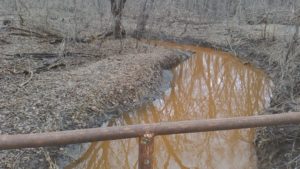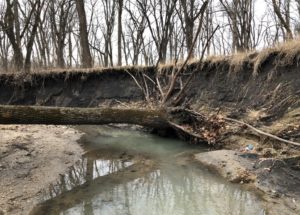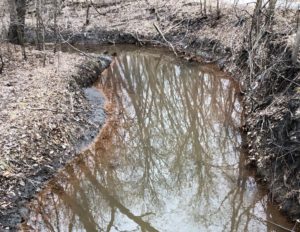“Is this pollution?” I received this photo, taken at 1PM on March 24, from Ames High School student Oskar Niesen. I met Oskar and other students in Mr. Todd’s environmental science classes for the first time in February, when we talked in the classroom about issues and solutions in Iowa waterways. The class was interested in testing water quality, so I met them again at the creek on March 22 and showed them how.
Let’s call the site of the incident “Ames High Creek.” It joins Ioway Creek near the disk golf course and originates with a 60 inch storm sewer pipe near the Richard Pohl Memorial Preserve (Ames High Prairie). The pipe drains several neighborhoods in north Ames (including mine) that were built before modern development ordinances requiring detention ponds. I’ve taken video of the torrent of water that comes out of the storm sewer after a heavy rain, and have seen the bank erosion it causes. I’ve also tested the water after rains and found high levels of bacteria, sediment and phosphorus levels in this creek during heavy rains. If people don’t pick up their trash, pet waste, or yard waste, there’s nothing to stop it from washing into to the creek. So I was prepared to answer “yes, the orange-brown color must be pollution.”
Later that evening, I visited the site and chatted with Jake Moore and Liz Calhoun with the City’s stormwater program. If someone had let muddy water wash off a construction site, or someone was pouring chemicals down the storm sewer, this would violate city ordinances and they would be the people to check up on it. But the timing wasn’t consistent with construction site runoff. There hadn’t been more than trace rain since Tuesday March 22nd.
Oskar had talked with a geology professor at Iowa State (Dr. Elizabeth Swanner) and suggested another possibility: iron oxide (rust), perhaps formed by naturally occurring bacteria. As Oskar explained “there are generally 3 types of iron oxide formations. One is a stain that we see now, the second is called flocculent iron which is a cloud that I saw then, the third is an iridescent film on the top. Bacteria tend to form all three.” At 5:00 on March 24, when I followed up on Oskar’s tip, the water had cleared up and there was no iridescent film, but there was stain on the rocks and at the water’s edge all the way up to the storm sewer outlet.
Hydrant flushing is done every year with the express purpose of flushing out iron oxide and other mineral deposits that can clog water mains. Liz Calhoun confirmed that crews flushed hydrants in neighborhoods connected to this storm sewer on March 24. A little rust in water can stain laundry but is harmless to people and fish. A release of drinking water can kill fish if it causes a sudden temperature change (this happened last summer when a water main broke) but in this case, we think there’s nothing to worry about. Mystery solved! The only thing more gratifying than working with curious young people and helpful colleagues is a happy ending for water quality!





